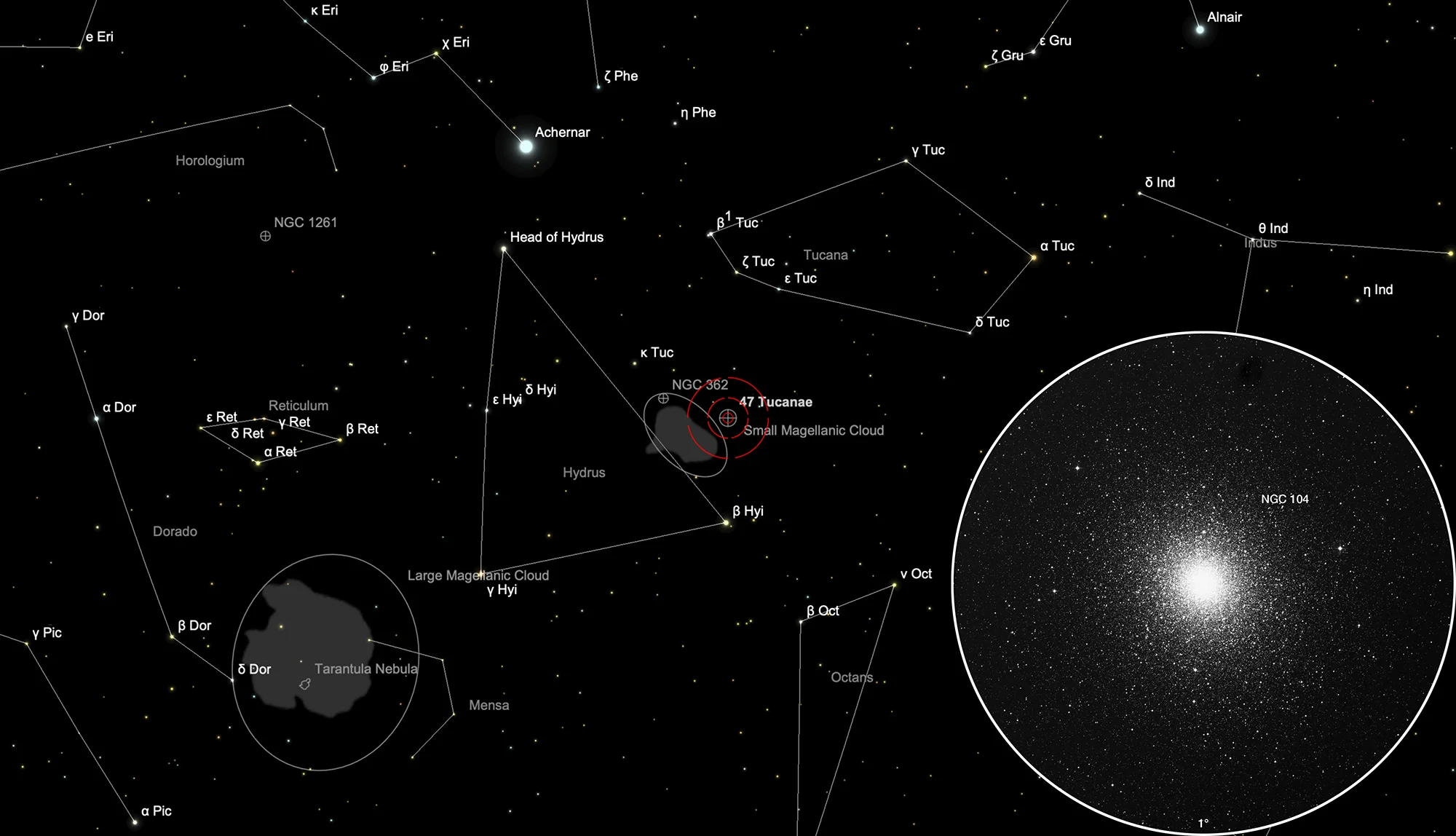47 Tucanae (NGC 104)


History
This object was first noted, but as a star and not a cluster in Bayer's Uranometria, which was published in 1603. In 1751-1752 the French astronomer Nicolas-Louis de Lacaille was on an expedition on the Cape of Good Hope, charting the southern constellations and observed the cluster with a 1/2-inch telescope at 8x magnification. He logged it as Lac I-1 and noted that it appeared «like the nucleus of a fairly bright comet». In Johann Bode's Uranographia of 1801 the «star» is listed as «47 Tucanae» originating from Bode's extension of Flamsteed numbers to the southern constellations. [364]
On 1 August 1826 Scottish astronomer James Dunlop observed with his 9-inch speculum reflector at his house in Parramatta in New South Wales. He logged the cluster as D 18 and noted: «(47 Toucan, Bode) this is a beautiful large round nebula, about 8' diameter, very gradually condensed to the centre. This beautiful globe of light is easily resolved into stars of a dusky colour. The compression to the centre is very great, and the stars are considerably scattered south preceding and north following.» [50]
John Herschel observing with his 18.25-inch reflector from Feldhausen, South Africa logged for h2322 the first note during sweep 441 (11 April 1834): «The great cluster preceding the Nubecula Minor. Estimated dia of the denser portion 5'; of the whole (not, however, including loose stragglers) 8'. Stars 14..16 mag. and one of 12th mag N.p. the centre. Excessively compressed. (N. B. In a sweep below the pole, when of course owing to the low altitude much of the light was lost.)»
On 12 August 1834 Herschel wrote «A most glorious cluster. The stars are equal, 14th mag., immensely numerous and compressed. Its last outliers extend to a distance of 2 min, 16 sec in RA from the centre. It is compressed to a blaze of light at the centre, the diameter of the more compressed part being 30 arcsec in RA. It is at first very gradual, then pretty suddenly very much brighter in the middle. It is completely insulated. After it has passed, the ground of the sky is perfectly black throughout the whole breadth of the sweep. There is a double star 11th mag. preceding the centre (Pos. 226.5 - 6.5 arcsec in RA from centre of neb.)»
On 21 September 1835 Herschel wrote: «Fills the field with its stragglers, condensation in three distinct stages, first very gradually, next pretty suddenly, and finally very suddenly very much brighter in the middle up to a central blaze whose diameter in RA is 13.5 sec and whose colour is ruddy or orange-yellow, which contrasts evidently with the white light of the rest. The stars are all nearly equal (12..14 mag). A stupendous object.»
Herschels final recording was on 5 Nov 1836: «A most magnificent globular cluster. It fills the field with its outskirts, but within its more compressed part, I can insulate a tolerably defined circular space of 90" dia wherein the compression is much more decided and the stars seem to run together; and this part I think has a pale pinkish or rose-colour.» [11]
Physical Properties
| Designation | NGC 104 |
| Type | GCL (III) |
| Right Ascension (J2000.0) | 00h 24m 05.2s |
| Declination (J2000.0) | -72° 04' 49" |
| Diameter | 50 arcmin |
| Visual magnitude | 4.0 mag |
| Metric Distance | 4.500 kpc |
| Dreyer Description | globular!! vB, vL, vmCM |
| Identification, Remarks | h 2322; GC 52; GCL 1; ESO 50-SC9; 47 Tuc |
Finder Chart
The globular cluster NGC 104 can be found in the constellation Tucana and is visible to the naked eye west of the Small Magellanic Cloud. Unfortunately it is not visible from Europe. On 30 September it in opposition with the Sun and is therefore highest in the sky at local midnight.
